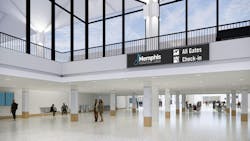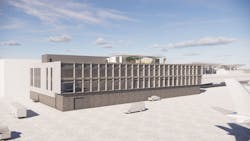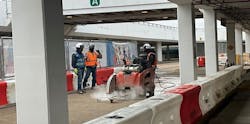Terminal Upgrades Transform Passenger Experience at Memphis International Airport
What You'll Learn in this Article

-
How Memphis International Airport is future-proofing a 1963 terminal to meet modern seismic, security, and passenger demands.
-
Why the Terminal Modernization and Seismic Program is reshaping curb-to-gate travel in the Mid-South.
-
What airport leaders are doing to minimize disruption while executing a six-year, live-terminal overhaul.
Memphis International Airport (MEM) is deep into the most ambitious capital improvement program in its history, an initiative aimed not only at modernizing aging infrastructure but also redefining the passenger journey from curb to gate.
The Memphis on the Move program, anchored by the Terminal Modernization and Seismic Program (TMSP), is unfolding as a multi-year transformation that reinforces safety, expands operational efficiency, and amplifies the traveler experience in the Mid-South.
Originally opened in 1963, the terminal structure at MEM was built in an era that predated seismic standards, security checkpoints, and today’s traveler expectations. As passenger volumes grew and airline operations evolved from hub-based to origin-and-destination service, the need for a comprehensive overhaul became apparent.
According to James Hay, senior director of terminal modernization planning and development for the Memphis-Shelby County Airport Authority, “Our building was constructed in 1963 and at the time it was not designed for the type of quantity of numbers that we're having go through that terminal.”
Morning departure banks, in particular, created congestion that made navigating the facility difficult and diminished the overall customer experience.
With a projected six-year timeline, the TMSP focuses on completely reimagining the passenger terminal while maintaining continuous operations.
That challenge, according to airport CEO Terry Blue, is akin to “renovating your kitchen, bedroom and bathroom while still living in the house.” The airport is addressing this through a series of carefully sequenced phases, supported by early stakeholder engagement and detailed logistics planning to maintain safety and minimize disruption.
One of the foundational priorities of the redesign is to create a more intuitive, open and accessible terminal layout. Blake Tyler, project executive for the TAC JBT A/C joint venture, said, “The new entrance of the B terminal, which is where most people come into the airport, will be widened. It gives you that intuition that I know exactly where I need to go because it’s almost highlighted because of the size.”
Tyler also noted the importance of increasing vertical circulation and options to improve movement and reduce confusion inside the terminal.
“There’s more escalators, and they’re laid out in such a way that you can go to the right or the left," he said. "It gives you more intuition of where you’re going.”
Hay added that outdated vertical circulation elements, such as escalators located directly in front of the security checkpoint, created passenger flow challenges and safety concerns.
“There ends up being a backup if we’re not very careful and don’t manage the line, a backup onto the escalator, which is a safety issue,” he said.
The redesign addresses this by relocating those elements and opening the building’s internal layout to improve flow and ease wayfinding.
This focus on passenger ease is a consistent theme throughout the project. MEM leadership and design teams leaned heavily into community feedback during early planning.
“Our community, by and large, loves this building,” Blue said, noting that preservation of the terminal’s iconic martini-glass columns and roofline was a key outcome from public focus groups.
Tyler emphasized that same priority in the design process.
“It’s important that we highlight that we started by understanding what are the features that are most important to preserve,” he said. “We’re not only preserving them, but really designing to highlight them.”
The updated terminal will honor these architectural features while replacing outdated materials with modern finishes, improved lighting, and sustainable elements that reduce energy consumption.
According to Hay, the airport is being intentional with both design and function.
“We’re trying to make it hidden,” he said of the seismic and fire safety upgrades. “We’re paying respect to the architecture of the building, but also adding function.”
The commitment to future-readiness is another defining aspect of the project. Infrastructure upgrades include the addition of a fiber-optic backbone to accommodate new technologies and smart airport systems.
“We’re installing a fiber backbone throughout so that as innovations come on board, we don’t have to go and run new fiber,” said Hay. “We’re being very generous in those installations.”
Tyler pointed to the reengineered baggage handling system as one of the most innovative elements.
“It’s really going to be a great selling point to airlines. I think it’s going to help them to be more efficient as well as TSA.”
Hay added that these infrastructure enhancements are being informed by lessons learned from peer airports and industry collaboration.
“I’m a member of the Southeast chapter of AAAE and a peer group of like professionals at airports. We’re constantly exchanging ideas and discussing projects like this,” he said. “We’re looking for the right technology fit for us all, and if one of us finds something really cool, we’re immediately sharing it.”
In terms of physical progress, major enabling work is already well underway. The demolition of Concourse A has created space for a future baggage inspection system and administrative offices, while also laying the groundwork for a consolidated rental car facility. A disused transit tunnel is being filled with concrete to support construction, and preparations are ongoing to tear down one of two upper-level ticketing drives to allow for seismic retrofits.
“Each one of the martini columns that are inside the terminal have to be completely upgraded from the foundation all the way up to the roof,” said Tyler. “Three of them have to be essentially upgraded at the same time, so you can’t just pick and choose.”
The project’s price tag stands at approximately $653 million. Funding is being sourced through a mix of airport revenue bonds, FAA grants, passenger facility charges, and other non-local-tax funds. The airport has been proactive in leveraging federal support and careful phasing to manage construction budgets amid ongoing cost volatility due to tariffs and supply chain issues.
“The hot topic in today’s world is tariffs,” Tyler noted. “It’s really just being very forward thinking.”
Looking ahead, MEM expects the full project to reach completion by 2030. The leadership team is focused on ensuring the airport remains easy to use, modern in its offerings, and memorable for its efficiency and design.
“If our customers feel as passionately about the front of the building as they did about our concourse modernization, we’ll know we’ve done it right,” Blue said.
Memphis International is building for the next generation of air travel while keeping the spirit of the city intact.
“We’re just going to extend that concept further into the terminal,” said Tyler. “People rave about the new concourse. They love flying out of Memphis. And we want to build on that.”
“We want this building to feel like Memphis,” Blue added. “Not just a place to travel through, but a gateway that reflects who we are.”
About the Author
Joe Petrie
Editor & Chief
Joe Petrie is the Editorial Director for the Endeavor Aviation Group.
Joe has spent the past 20 years writing about the most cutting-edge topics related to transportation and policy in a variety of sectors with an emphasis on transportation issues for the past 15 years.
Contact: Joe Petrie
Editor & Chief | Airport Business
+1-920-568-8399
>> To download the AviationPros media kits, visit: Marketing Resource Center
>>Check out our aviation magazines: Ground Support Worldwide | Airport Business | Aircraft Maintenance Technology


